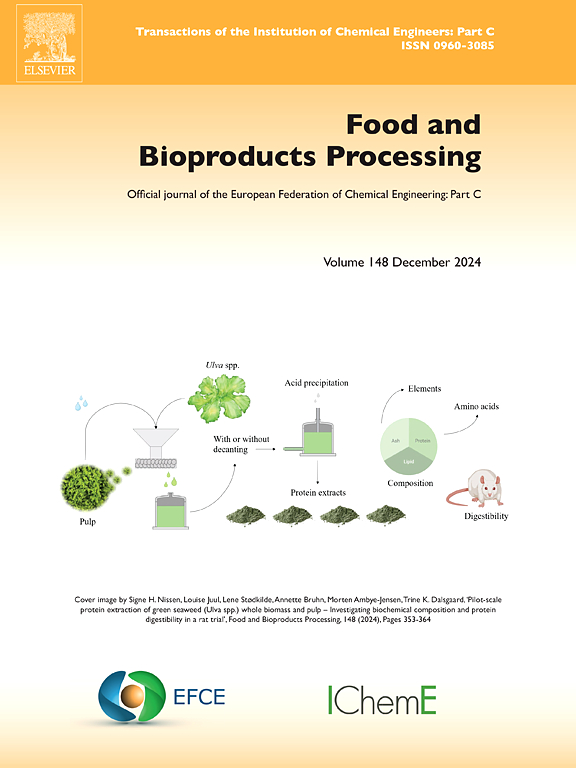Development and Protective Mechanism of a Freeze-Drying Protectants Against Freeze-Drying for Lactiplantibacillus plantarum W1
IF 3.4
2区 农林科学
Q2 BIOTECHNOLOGY & APPLIED MICROBIOLOGY
引用次数: 0
Abstract
Lactiplantibacillus plantarum (L. plantarum) has promising applications in the development of probiotics, largely based on its recently recognized role in the gut–heart–brain axis. However, its survival rate after freeze-drying and its storage stability are key factors limiting the development and application of L. plantarum. In this study, we mixed skimmed milk, trehalose, and inulin (SMTI) in a 1:8 mass ratio with L. plantarum W1, followed by freeze-drying. The results showed that using SMTI as a protectant could increase the freeze-dried survival rate to 86.87%+0.9%. After 1 month, the viability of the freeze-dried bacterial cells was 2.87+0.44×109 CFU/g. By measuring relevant enzyme activities, we found that the addition of this protectant enhanced the activity of Na+-K+-ATPase, Ca2+-Mg2+-ATPase, and total ATPase during freeze-drying. These enzyme activities maintained the integrity of the L. plantarum W1 cell membrane and reduced the leakage of lactate dehydrogenase and β-galactosidase. Therefore, SMTI improved the freeze-dried survival rate of L. plantarum W1 and increased its resistance to adverse conditions. Our study provides a new formula for a probiotic protectant, offering a new method by which to preserve probiotic strains during freeze-drying.

植物乳杆菌 W1 冷冻干燥保护剂的开发与保护机制
植物乳杆菌(L. plantarum)在益生菌开发中具有广阔的应用前景,主要基于其最近在肠-心-脑轴中的作用。但其冷冻干燥后的成活率和贮藏稳定性是制约植物乳杆菌开发利用的关键因素。本研究将脱脂牛奶、海藻糖和菊粉(SMTI)以1:8的质量比与植物乳杆菌W1混合,然后冷冻干燥。结果表明,SMTI作为保护剂可使冻干成活率提高86.87%+0.9%。1个月后,冻干细菌细胞活力为2.87+0.44×109 CFU/g。通过对相关酶活性的测定,我们发现在冷冻干燥过程中,加入该保护剂可以提高Na+-K+- atp酶、Ca2+-Mg2+- atp酶和总atp酶的活性。这些酶的活性维持了植物乳杆菌W1细胞膜的完整性,减少了乳酸脱氢酶和β-半乳糖苷酶的渗漏。因此,SMTI提高了L. plantarum W1的冻干存活率,增强了其抗逆性。本研究提供了一种新的益生菌保护剂配方,为冷冻干燥过程中益生菌菌种的保存提供了一种新的方法。
本文章由计算机程序翻译,如有差异,请以英文原文为准。
求助全文
约1分钟内获得全文
求助全文
来源期刊

Food and Bioproducts Processing
工程技术-工程:化工
CiteScore
9.70
自引率
4.30%
发文量
115
审稿时长
24 days
期刊介绍:
Official Journal of the European Federation of Chemical Engineering:
Part C
FBP aims to be the principal international journal for publication of high quality, original papers in the branches of engineering and science dedicated to the safe processing of biological products. It is the only journal to exploit the synergy between biotechnology, bioprocessing and food engineering.
Papers showing how research results can be used in engineering design, and accounts of experimental or theoretical research work bringing new perspectives to established principles, highlighting unsolved problems or indicating directions for future research, are particularly welcome. Contributions that deal with new developments in equipment or processes and that can be given quantitative expression are encouraged. The journal is especially interested in papers that extend the boundaries of food and bioproducts processing.
The journal has a strong emphasis on the interface between engineering and food or bioproducts. Papers that are not likely to be published are those:
• Primarily concerned with food formulation
• That use experimental design techniques to obtain response surfaces but gain little insight from them
• That are empirical and ignore established mechanistic models, e.g., empirical drying curves
• That are primarily concerned about sensory evaluation and colour
• Concern the extraction, encapsulation and/or antioxidant activity of a specific biological material without providing insight that could be applied to a similar but different material,
• Containing only chemical analyses of biological materials.
 求助内容:
求助内容: 应助结果提醒方式:
应助结果提醒方式:


